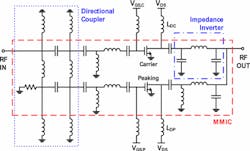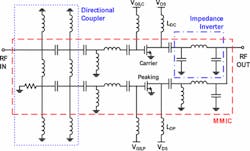GaN MMICs For Small Cells Get A Doherty Power Boost
Using a 0.25-μm gallium-nitride-on-silicon-carbide (GaN-on-SiC) process, a monolithic-microwave-integrated-circuit (MMIC) power amplifier (PA) promises to meet the power, size, and cost considerations of small-cell applications. With support from the IT R&D Program of MSIP/KEIT, Republic of Korea, Cheol Ho Kim, Seunghoon Jee, Gweon-Do Jo, Kwangchun Lee, and Bumman Kim designed and tested the 2.14-GHz hybrid-Doherty PA. To achieve low part count and reasonable efficiencies in a compact package, the team used an unconventional and uneven power-splitting technique.
For the nonsymmetrical configuration, different-sized PAs were used. The peak amplifier was sized larger than the carrier amplifier for greater backoff characteristics, which resulted in a higher peak-to-average power ratio (PAPR). This design decision helped the PA achieve a higher data rate capable of supporting 4G and LTE requirements. To further reduce size, low-loss chip inductors were placed around the MMIC die. They reduced the inductor circuit footprint by a factor of 10.
Exhibiting a high drain efficiency of 52.7%, the PA provided output power to +22.2 dBm. It achieves an adjacent power leakage rate of -49.6 dBc for an LTE signal. The peak-to-average power ratio (PAPR) reached 7.1 dB after the digital-predistortion linearization. See “A 2.14-GHz GaN MMIC Doherty Power Amplifier for Small-Cell Base Stations,” IEEE Microwave and Wireless Components Letters, April 2014, p. 263.
This file type includes high resolution graphics and schematics when applicable.
About the Author
Jean-Jacques DeLisle
Jean-Jacques graduated from the Rochester Institute of Technology, where he completed his Master of Science in Electrical Engineering. In his studies, Jean-Jacques focused on Control Systems Design, Mixed-Signal IC Design, and RF Design. His research focus was in smart-sensor platform design for RF connector applications for the telecommunications industry. During his research, Jean-Jacques developed a passion for the field of RF/microwaves and expanded his knowledge by doing R&D for the telecommunications industry.


